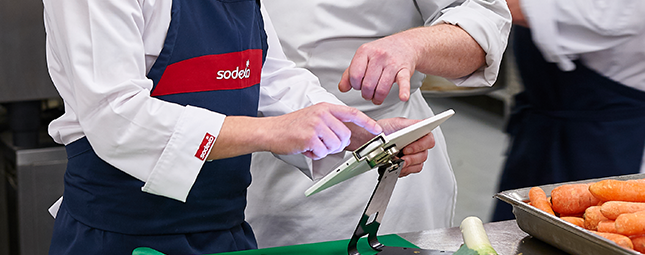Food Waste Intelligence
Subscribe to Food Waste Intelligence
Get our latest posts delivered right to your inbox.
Sodexo rolls out Leanpath at 1,200 sites globally - Food Waste

As soon as the COVID-19 pandemic reached the U.S., Vidant Medical Center in eastern North Carolina began to prepare for the potential of overcrowding, supply chain interruptions, and overwhelming strain on the staff. To support the patients and staff, Vidant’s dining services team jumped in to adapt their operations.
“Our customer base dropped dramatically almost overnight,” said Troy Sheppard, Food & Nutrition Service Line Administrator and Client Executive with Sodexo, which provides dining operations for Vidant Health system. Increased staffing demands created further challenges, as self-serve food lines were converted to staffed stations and heightened sanitation protocols required more labor time. A shifted focus on quick service dining changed the norm even further.
Changing operations and supporting the staff in a pandemic didn’t mean the Sodexo team would abandon their sustainability commitments. On the contrary, Sodexo has continued rolling out its food waste prevention platform, WasteWatch powered by Leanpath (WWxLP), globally, despite the pandemic. WWxLP has deployed at 732 Sodexo sites, including 188 healthcare sites in the US, nearly all since the onset of COVID-19. More than 1,200 Sodexo kitchens globally are currently in the program.
At Vidant, WWxLP allows the foodservice team to refine their ability to measure food waste, to receive detailed reports on what is being wasted and why, and to develop plans to prevent future waste. With so many norms of operation upended, the ability to understand food waste in real time allowed the foodservice team at Vidant to see where adjustments were needed immediately. “Vidant values our partnership with Sodexo and together we both share a deep commitment for creating a path of sustainability as well as creating a healthy and tasty dining experience at our hospitals throughout eastern North Carolina.” Dr. Julie Kennedy Oehlert, Chief Experience Officer for Vidant Health.
With so many norms of operation upended, the ability to understand food waste in real time allowed the foodservice team at Vidant to see where adjustments were needed immediately.
“Sodexo prioritizes addressing food loss and waste because, as a major player in the food value chain, it is imperative for our business and for the planet,” said Nell Fry, Senior Manager of Corporate Social Responsibility at Sodexo. “This is even more true during COVID with tremendous volatility in supply and demand along with an ever-changing consumer landscape. The need to measure food waste has never been more clear or necessary.”
According to data from Leanpath, the percentage of food wasted in kitchens typically increases as the amount of food produced decreases, a particular concern as production levels have fallen due to COVID restrictions.
“When it comes to food waste, high production levels create a lot of buffer for kitchens,” explains Leanpath Executive Chef Robb White. “Because there is simply more food being served there are more opportunities, for instance, to repurpose overproduction. Likewise, when you’re moving through product faster, you have less opportunity to create waste through spoilage or expiration.”
Vidant comprises nine hospitals and 1,708 licensed beds offering extensive inpatient and outpatient services to more than 1.4 million people across 29 counties. Its foodservice operation covering patient dining, retail and catering produces 1.2 million meals annually. That production level had dropped as much as 46 percent at the height of COVID, now recovering several percentage points.
Learning and adjusting at Vidant
Since the Sodexo team at Vidant began tracking its waste, they were able to quickly and precisely spot increased waste trends throughout the week.
Sodexo Executive Chef Andrew Loesch runs the kitchen at Vidant’s Duplin Hospital. Through food waste tracking, he and his team noticed high waste levels from expired items, particularly on Mondays.
Loesch explains. “With the detail from WasteWatch powered by Leanpath it’s allowing us to ensure everybody is doing a better job going through the walk-ins and coolers making sure everything is being utilized [before it expires].”
Vegetable waste ranked as the highest waste item overall. Through Leanpath’s automated goal function, the team began working on a goal to reduce vegetable waste by 10 percent. Leanpath monitored and reported on their progress. The team ultimately reduced waste from vegetables by 25 percent.
“We achieved that mainly by stressing small batch cooking and cooking to order fresh vegetables,” Loesch said. “It might mean a little more work, but when they see those waste numbers at the end of the day, it really clicks.”
Loesch continued: “We have to be good stewards of our food sources, our planet and our client’s finances. Because Vidant is so big and reaches so many people we can really positively impact all that.”
“The old adage, a penny saved is a penny earned, is real, and now more than ever in my career in the healthcare field,” Sheppard added. “Our clients hire us to be the experts in managing the resources to be sustainable as well as saving costs. WasteWatch powered by Leanpath aligns with that perfectly.”
Sodexo works in 64 countries and serves up to 100 million consumers daily. The company made history in 2019, by announcing plans to be the first global foodservice organization to roll out automated food waste tracking solutions at all its sites by 2025.
Sign up for our monthly newsletter in the footer below for the latest in
food waste prevention initiatives, best practices, webinars and more.